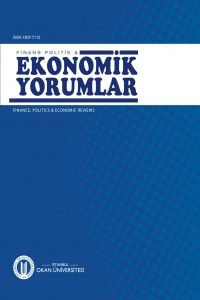Finansal İstikrarı Sağlamaya Yönelik Alternatif Politika Çerçeveleri
Küresel finansal krizin, finansal dengesizliklerle mücadelede geleneksel makroekonomik politika çerçevesinin yetersiz kaldığını açık bir şekilde ortaya koyması politika yapıcıları alternatif politika arayışlarına yöneltmiştir. Bu doğrultuda sistemik riskleri ve bunun neden olabileceği olumsuz dışsallıkları kontrol altına almak, olası şoklar karşısında finansal sistemin direncini güçlendirmek ve diğer iktisat politikalarının etkinliğini arttırmak amacıyla makro ihtiyati politikalar tanımlanmıştır. Makro ihtiyati politikaların tanımlanması ile birlikte, para politikasının finansal sistemdeki gelişmeler karşısındaki tutumuna ilişkin geleneksel reaktifproaktif politika tepkisi tartışması, finansal istikrarı sağlamaya yönelik politika çerçevesi tartışmasına dönüşmüştür. Kriz sonrası dönemde, politika yapıcıların finansal dengesizliklere proaktif tepki vermesi yönünde varılan uzlaşıya karşın bu tepkinin hangi politika veya politika bileşimi ile verileceği, politikalar arasındaki ilişkinin ve koordinasyonunun ne olacağı başlıca tartışma konularını oluşturmuştur. Bu çerçevede çalışma ile para ve makro ihtiyati politikaların farklı şekillerde yürütülebildiği finansal istikrara yönelik alternatif politika çerçevelerinin ortaya koyulması ve politika çerçevelerinin karşılaştırmalı analizinin gerçekleştirilmesi amaçlanmıştır.
Anahtar Kelimeler:
Finansal İstikrar, Para Politikası, Makro İhtiyati Politikalar, Sistemik Risk
Alternative Policy Frameworks for Financial Stability
The fact that global financial crisis has showed clearly that the traditional macroeconomic policy framework is insufficient to fight against financial imbalances has led the policy makers to seek alternative policies. In this direction, in order to control systemic risks and the negative externalities caused by these risks, to strengthen the resistance of the financial system in the face of possible shocks and to increase the effectiveness of other economic policies, macro-prudential policies have been defined. With the definition of macroprudential policies, the traditional discussion of the reactive-proactive policy response regarding the monetary policy’s attitude towards developments in the financial system has turned into a discussion of the policy framework for achieving financial stability. Despite the consensus on policymakers’ proactive response to financial imbalances in the post-crisis period, ‘which policy or policy composition will be provided with this response and what the relationship and the coordination between policies will be’ have been the main discussion topics. In this context, it is aimed to provide alternative policy frameworks for financial stability in which monetary and macroprudential policies can be implemented in different ways, and to provide a comparative analysis of policy frameworks.
___
- ADRIAN, T. and Hyun Song SHIN; (2008), “Liquidity and Leverage”, Federal Reserve Bank of New York Staff Reports, No. 328.
- AGENOR, Pierre-Richard and Luiz A. PEREIRA da SILVA; (2012), “Macroeconomic Stability, Financial Stability and Monetary Policy Rules”, International Finance, Vol. 15, No. 2, pp. 205-224.
- AGENOR, Pierre-Richard and Luiz A. PEREIRA da SILVA; (2013a), “Inflation Targeting in a Post-Crisis World”, http:// www.iadb.org/res/CentralBanks/publications/cbm73_1094. pdf., (05.06.2017).
- AGENOR, Pierre-Richard and Luiz A. PEREIRA da SILVA; (2013b), “Inflation Targeting and Financial Stability: A Perspective From the Developing World”, Inter-American Development Bank and CEMLA.
- AKINCI, Özge and Jane OLMSTEAD-RUMSEY; (2015), “How Effective are Macroprudential Policies? An Empirical Investigation” International Finance Discussion Papers, No. 1136.
- ANGELONI, Ignazio and Ester FAIA; (2013), “Capital Regulation and Monetary Policy with Fragile Banks” Journal of Monetary Economics, Vol. 60 No. 3, pp. 311-324.
- ALTUNBAŞ, Yener, Leonardo GAMBACORTA, David
- MARQUES-IBANEZ; (2012), “Do Bank Characteristics Influence the Effect of Monetary Policy on Bank Risk?” ECB Working Paper Series, No. 1427.
- BAŞÇI, Erdem ve Hakan KARA; (2011), “Finansal İstikrar ve Para Politikası” TCMB Çalışma Tebliği, No. 08.
- BEAU, Denis, Laurent CLERC and Benoit MOJON; (2012), “Macro-Prudential Policy and the Conduct of Monetary Policy” Banque de France Working Papers, No. 390.
- BERNANKE, Ben. S; (2010), “Causes of the Recent Financial and Economic Crisis” Statement Before the Financial Crisis Inquiry Comission. BORIO, Claudio; (2006), “Monetary and Financial Stability: Here to Stay?” Journal of Banking and Finance, No. 30, pp. 3407-3414.
- BORIO, Claudio ve Haibin ZHU; (2008), “Capital Regulation, Risk Taking and Monetary Policy: A Missing Link in the Transmission Mechanism?” BIS Working Papers, No. 268.
- BORIO, Claudio; (2014a), “Monetary Policy and Financial Stability: What Role in Prevention and Recovery?” BIS Working Papers, No. 440.
- BORIO, Claudio; (2014b), “The Financial Cycle and Macroeconomics: What Have We Learnt?” Journal of Banking and Finance, No. 45, pp. 182-198.
- BORIO, Claudio; (2016), “Towards a Financial Stability-Oriented Monetary Policy Framework?” Conference on the Occasion of the 200th Anniversary of the Central Bank of the Republic of Austria, Vienna.
- CARRE, Emmanuel, Jezabel, COUPPEY-SOUBEYRAN and Salim DEHMEJ; (2014), “Augmented Taylor Rule versus Macroprudential Rule What DSGE Models Tell Us?”, http://metaanalysis2014.econ.uoa.gr/fileadmin/metaanalysis2014.econ. uoa.gr/uploads/Dehmej_Salim.pdf., (15.05.2017)
- CERUTTI, Eugenio, Stijn CLAESSENS and Luc LAEVEN; (2015), “The Use and Effectiveness of Macroprudential Policies: New Evidence” IMF Working Paper, No. 61.
- CLAESSENS, Stijn, Swati R. GHOSH and Roxana MIHET; (2014), “Macro-Prudential Policies to Mitigate Financial System Vulnerabilities”, IMF Working Papers, No. 155.
- COLLARD, Fabrice, Harris DELLAS, Behzad DIBA and Olivier LOISEL; (2012), “Optimal Monetary and Prudential Policies”, Centre de Recherche en Economie et Statistique Working Papers, No. 34
- ISSN: 1307-7112
- Başlangıç: 1963
- Yayıncı: İstanbul Okan Üniversitesi
Sayıdaki Diğer Makaleler
Türkiye’de Büyükşehir Belediyelerinin Bütçe Sürdürülebilirliği Üzerine Bir Uygulama
Mehmet DAĞ, Oktay KIZILKAYA, Fatma KIZILKAYA
Mustafa Kemal YILMAZ, Orkun İÇTEN
Finansal İstikrarı Sağlamaya Yönelik Alternatif Politika Çerçeveleri
Amasya Üniversitesinin İl Ekonomisine Etkisi
Rüştü YAYAR, Hilal ŞEKER, Nagehan KARANFİL
Para Politikasının Etkilerinde Sektörel Asimetriler: Türkiye İçin VAR Analizi
